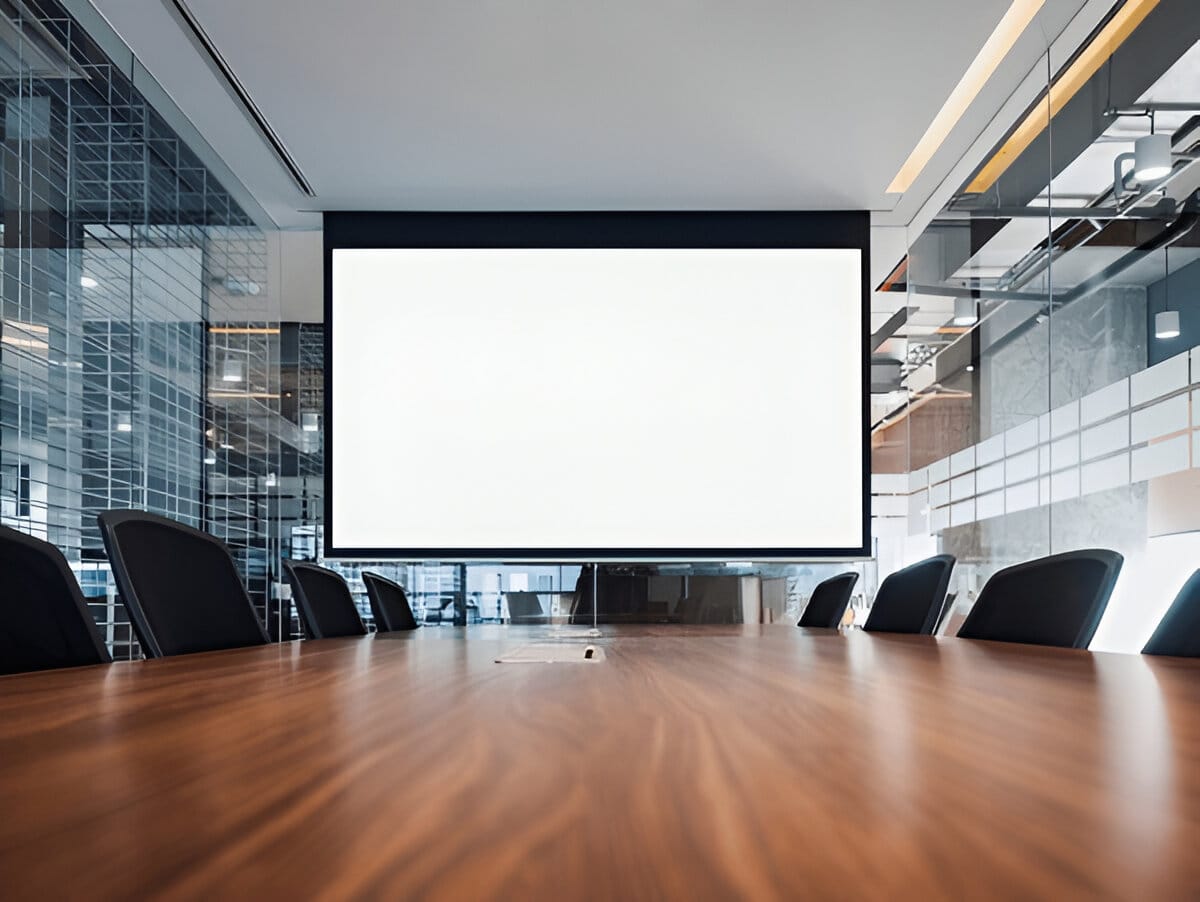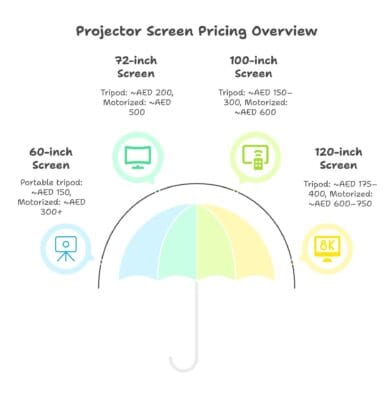Projector Screens in Dubai: Types, Sizes, Prices & Installation Guide

A projector screen is a specially designed surface for displaying images from a projector, providing a flat, color-neutral canvas that enhances picture quality. This makes projected visuals appear clearer and more vibrant – crucial for home theaters, business presentations, or outdoor movie nights. In home entertainment and events scene, projector screens are popular because they can turn any space into a cinematic experience. If you’re looking for the best projector screen in Dubai, this comprehensive article can help to understand the different types available, what sizes suit your needs, and how to install them for optimal viewing.
Types of Projector Screens
Projector screens come in various types to fit different use-cases and environments. Below we explore common categories – from wall-mounted solutions to portable and outdoor screens – as well as typical screen sizes:
Projector Screen for Wall
Wall-Mounted Screens: These screens are fixed in place on your wall (or ceiling) and roll up when not in use. They can be manual pull-down or motorized electric screens that lower at the push of a button. Wall-mounted screens are great for dedicated media rooms or conference rooms where you want a clean, permanent installation.
Using a Plain Wall: It’s also possible to use a plain white wall as a projection surface in a pinch – some people even paint a section of wall with special projector-screen paint. This is cost-effective, but keep in mind that a wall won’t have the reflective quality or uniformity of a purpose-built screen.:
Can I use my wall as a projector screen?
addresses this in detail, but in short – yes, you can, although a proper screen will typically look better.
Mounting Options: Most projector screens (manual or motorized) can be mounted on a wall just like a flat-panel TV. You’ll use brackets or anchors to secure the screen’s case to the wall (or ceiling) at the desired height. Wall-mounting is straightforward and commonly done, so if you’re wondering “can you mount a projector screen on a wall?” – the answer is absolutely yes. Just ensure you use appropriate hardware for the wall material (drywall plugs, concrete anchors, etc.) to support the screen’s weight.
Portable Projector Screens

Not everyone in Dubai has a dedicated theater room – sometimes you need a screen you can move around or set up temporarily. Portable projector screens are ideal in these cases. They usually come with a tripod stand or foldable frame:
- Tripod Screens: A tripod projector screen has an attached tripod stand and a pull-up screen surface. They are lightweight and easy to set up: just open the tripod legs, extend the screen, and you’re ready to go. When finished, it retracts and folds into a carry case. Tripod screens are one of the most popular portable options for office presentations or mobile outdoor use because they don’t limit you to one location.
- Foldable Frame Screens: These screens have a collapsible frame (often made of tent-pole like sections) and a fabric screen that attaches via snaps or straps. They can be larger than tripod screens and provide a taut, flat surface. Foldable screens often come with their own stands or can be hung, and they pack down into a bag for transport. They’re great for traveling business presenters or for pop-up movie nights in different venues.
Portable screens are convenient for their mobility. In Dubai, you can find portable projector screens in sizes ranging from small 50–60 inch table-top screens up to about 100–120 inches diagonal. They’re perfect if you need to move the screen between rooms or buildings frequently (for example, taking a screen to a client’s office for a presentation).
Outdoor Projector Screens
Inflatable and Outdoor Screens: For movie nights under the stars or big outdoor events in Dubai’s pleasant winter months, outdoor projector screens are a must. Inflatable screens (as shown above) are popular for community movie events and backyard cinemas. Setup involves staking the screen down and keeping an air pump running to maintain inflation. Once deflated, it folds up for storage.
Portable Frame Outdoor Screens: Aside from inflatables, some outdoor screens use metal frames with guy ropes and stakes for stability. These usually use weather-resistant fabric and can handle a breeze better than a free-standing indoor screen. Outdoor screens are often weatherproof or at least made of materials that dry quickly and resist mildew, given the occasional humidity or dew. If you plan outdoor projector nights in Dubai, look for screens labeled for outdoor use, as they’ll be sturdier and sometimes come with leg weights or tie-downs.
Projector Screens by Size
Projector screens are measured diagonally (just like TVs) in inches. Common sizes include 60-inch, 72-inch, 100-inch, and 120-inch screens, among others. The right size for you depends on your room and audience size. Here’s a quick overview of these sizes and their typical use cases
:
- 60-inch Screen: This is on the smaller end for projectors – roughly 4ft diagonal. Screens in the 50–60″ range are considered “small” and are usually used for personal viewing or very small rooms. In Dubai, a 60-inch projector screen might be used in a bedroom or a tight office where a larger display won’t fit. (Note: many people with limited space might simply opt for a large TV at this size, but a projector screen is still viable if you already have a projector.)
- 72-inch Screen: A 72″ (6ft) diagonal screen is slightly larger and often found as a portable tripod screen size. This is still relatively small-medium – good for small group presentations or a cozy home setup. It can comfortably display to a few people in a meeting room or a small classroom. Because 72″ screens are common with tripod stands, they’re popular in office supply stores.
- 100-inch Screen: Around 100″ (8.3ft diagonal) is one of the most popular sizes for home theater setups – it gives a big image without being overwhelmingly large for an average room. Screens between ~80″ and 120″ are considered medium-sized, ideal for typical living rooms, basements, or conference rooms. In a Dubai villa or apartment, a 100-inch screen can turn your living area into a mini cinema, assuming you have about 3–4 meters of throw distance for the projector.
- 120-inch Screen: A 120″ (10ft) screen is on the larger side of home use and is often the choice for dedicated home theater rooms or bigger conference spaces. It provides a truly immersive experience. This size is about as wide as a king-size bed is long! Medium-to-large screens like 120″ work well in bigger rooms or small halls. In Dubai, enthusiasts build home cinemas with 120″ fixed-frame screens paired with high-end projectors. Just ensure your projector’s lumen output and your room can accommodate this size – you’ll want a dim or dark environment to get the best contrast at 120 inches.
Keep in mind that larger screens need more distance from the projector (unless you have a short-throw model) and may require a brighter projector to maintain a vivid image. The 4-6-8 rule (discussed later) can help determine how far your viewers can sit for a given screen height, which indirectly guides you on choosing a screen size appropriate for your space.
Projector Screens in Dubai
Dubai offers plenty of options when it comes to purchasing projector screens. Whether you’re looking for budget-friendly models or top-of-the-line brands, here’s where and what to consider:
- Dragon Mart: One of the most popular places to find affordable projector screens in Dubai is Dragon Mart (in the International City area). Dragon Mart houses many shops selling electronics and AV equipment, including projector screens of all sizes. For example, the Toppro brand, known for its value-for-money projector screens, has a store in Dragon Mart
topprosound.com
. You can find tripod screens, pull-down screens, and motorized screens here often at lower prices than big-box retailers. If you’re wondering where to buy projector screens in Dubai for a bargain, Dragon Mart should be high on your list. Do inspect the quality, as items can range from basic to professional grade. - AV Specialty Stores: Dedicated audio-visual (AV) suppliers and home theater shops across Dubai also carry projector screens. Toppro is one recommended brand – not only available at Dragon Mart, they also sell online and through AV dealers, offering screens in various formats (tripod, wall-mounted, motorized). Toppro’s screens are popular in the UAE for balancing quality and price; for instance, their portable tripod projector screens come in multiple sizes ranging roughly from AED 130 up to AED 590 depending on size.
- Professional AV Integrators: If you need high-end solutions (like a tensioned screen that hides in the ceiling or a massive conference room installation), companies in Dubai that specialize in AV integration can source and install projector screens for you. Brands like TopPro (premium screens) might not be on shelf in retail stores but can be ordered via these integrators.
When choosing where to buy, consider after-sales support as well. Local warranty and the ability to see a demo can be advantages of buying from a physical store or authorized dealer. For everyday consumers, however, Dragon Mart and online platforms likely offer the most variety and best projector screen deals in Dubai.
Recommended Brand – Toppro: As mentioned, Toppro projector screens are a popular choice in the Dubai market. They offer both tripod and motorized screens at attractive prices. For instance, Toppro’s 150-inch motorized screen (a huge size suitable for auditoriums or large halls) was retailing around AED 650 on sale (originally about AED 900). This is a very competitive price for that size. Their more common sizes (like 100″ or 120″) in tripod form are typically much cheaper – often in the low hundreds of dirhams. So if you’re seeking value, Toppro is a brand to look out for. Always ensure the screen’s aspect ratio (e.g., 16:9 widescreen vs 4:3) matches your projector and usage.
Cost of Projector Screens in Dubai

Projector screen prices in Dubai vary widely based on size, type, and brand. Portable screens tend to be cheaper than fixed or motorized ones, and smaller sizes cost less than large ones. Below is an approximate price chart comparing common screen sizes and types:
| Screen Size (Diagonal) | Typical Price – Tripod/Manual Screen | Typical Price – Motorized Screen |
| 60-inch (small) | ~AED 150 (portable tripod) | Not common as motorized (≈ AED 300+ if available) |
| 72-inch (small) | ~AED 200 (portable tripod) | ~AED 500 (motorized) |
| 100-inch (medium) | ~AED 150–300 (depends on brand/stand) | ~AED 600 (motorized with remote) |
| 120-inch (medium) | ~AED 175–400 (tripod or fixed frame) | ~AED 600–750 (motorized) |
Notes: These prices are approximate ranges as of current market rates in Dubai. For example, a basic 100″ manual pull-down screen might be around AED 200, whereas a high-quality 100″ motorized screen with remote could be AED 600 or more. We can see that larger motorized screens (120″ and above) often range between AED 600–800 from mid-range brands
Projector Screen Installation in Dubai
Getting your projector screen set up at the right spot is crucial for the best viewing experience. Here are key points regarding installation, costs, and setup best practices:
Professional Installation Services: If you’ve purchased a motorized screen or a large fixed screen, you might want it professionally installed, especially if it needs to be ceiling mounted or recessed. In Dubai, many AV companies offer installation services. Even major electronics retailers provide this – for instance, Sharaf DG lists a projector screen (motorized) installation service for around AED 400.
DIY Installation: Many projector screens are DIY-friendly if you’re comfortable with tools. Wall-mounted screens usually have brackets that you screw into the wall (make sure to hit a stud or use strong anchors). Mark your holes carefully, ensure the bracket is level, and get a friend to help lift the screen into place. Always follow the manufacturer’s instructions. If it’s a motorized screen, you’ll also need a power outlet nearby (or have an electrician handle the wiring if you want a concealed connection). In Dubai, most houses have concrete walls, so use a hammer drill and proper plugs for mounting. If unsure, it might be worth paying a pro to avoid any costly mistakes (like a screen falling down!).
Optimal Setup & Height: The goal is to mimic a comfortable viewing angle as if you were in a movie theater or a well-set-up conference room. A common guideline is to position the screen so that the center of the screen is roughly at the viewers’ eye level when seated. This prevents neck strain from looking too far up or down. In practical terms, for a home theater, that often means the bottom of the screen might be around 2 to 3 feet (60–90 cm) above the floor (because large screens ~100” tall will place the center roughly at eye height). For example, mounting a 100″ screen, you might end up with the bottom edge ~70 cm off the floor for optimal viewing – adjust based on your seating height. In an office, if people are sometimes standing, you might go a bit higher. The key is everyone should have a clear view of the screen without craning their necks.
Also consider the projection alignment: ideally the projector should be perpendicular to the screen (both centered horizontally and at the correct vertical offset) to avoid keystone distortion. If you ceiling-mount a projector, you’ll angle it down slightly or use lens shift to hit the screen center without distortion.
The 4/6/8 Rule: This is a handy rule-of-thumb in AV to determine how far your audience can sit relative to screen size. It states:
- For detailed viewing (like small text or data – think spreadsheets or detailed designs), the farthest viewer should be no more than 4 times the screen height away.
- For general viewing of presentations or large text, the farthest viewer can be about 6 times the screen height away.
- For cinema or video (passive viewing) where you don’t need to read fine details, up to 8 times the screen height is an acceptable viewing distance.
Delivery Options
One of the advantages of buying AV gear in a metro like Dubai is the convenient delivery services available. Most retailers and online platforms provide delivery to your doorstep, often covering all of the UAE. Here’s what you need to know about getting your projector screen delivered:
- Local Delivery in Dubai: If you purchase from a local store or an online UAE retailer, delivery within Dubai is usually fast – often within 1-2 days for in-stock items. Many stores offer free delivery within Dubai for larger items or orders over a certain amount
topprosound.com
. For example, some AV shops advertise free shipping in Dubai, which is great if you’re buying a large screen that you can’t easily carry home yourself. Always check if assembly is included; generally for a screen it’s not needed, but if you purchased installation service, the delivery person might install it as well. - Store Pickup vs. Delivery: If you buy from a physical store like those in Dragon Mart or malls, you may need to arrange transport if the screen is large. Some stores in Dragon Mart might have the item in stock for you to carry out; others can arrange a driver to deliver for a fee if it won’t fit in your car. However, given traffic and convenience, many people in Dubai prefer to have items delivered even if bought in person.
In summary, getting a projector screen delivered in Dubai (or anywhere in the UAE) is usually hassle-free. Just ensure you provide clear address details (with any specific landmarks if needed for villas). And when the item arrives, check the packaging for damage – projector screens have mechanical parts that you want to be sure are intact after transit. The good news is retailers here are accustomed to handling and shipping such electronics, making the whole process smooth for the buyer.
FAQs
- Can I use my wall as a projector screen? – Yes, you can project directly onto a wall, and many people do this initially to save cost. For the best results, the wall should be flat, smooth, and painted white or a light neutral color. In short, a wall can suffice for casual use, but if you want crisp, high-contrast images, a proper screen is better.
- Can you mount a projector screen on a wall? – Absolutely. Most projector screens (manual pull-down or motorized) are designed to be mounted on a wall or ceiling.
- Is 4K better than an HD projector screen? – This is a bit of a trick question. Projector screens themselves don’t have a “resolution” – the terms 4K or HD usually refer to the projector’s resolution.
- What is the best setup for a projector screen? – The best setup involves a few key things: proper placement, correct height, and the right environment. Also consider the 4/6/8 rule mentioned earlier for viewing distance – ensure your seating isn’t too far back for the content type.
- How much does it cost to install a projector screen? – Installation costs can vary. For professional installation by an AV company – especially for a motorized screen or a complex ceiling recess – the cost is higher. For example, one retailer offers motorized projector screen installation for about AED 400
By understanding the types of projector screens, considering the optimal size for your needs, and knowing where to buy one in Dubai, you’re well on your way to creating an impressive viewing setup. Whether it’s for enjoying movies at home, delivering impactful business presentations, or hosting outdoor film nights, the right projector screen makes all the difference in image quality and audience experience. Enjoy your big-screen adventures







